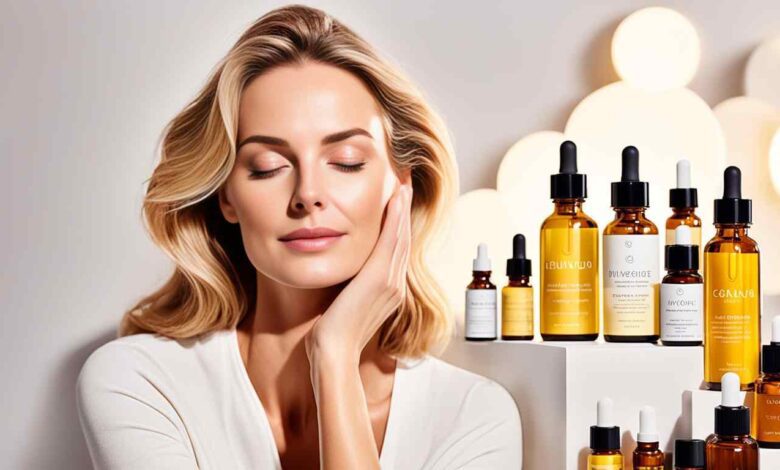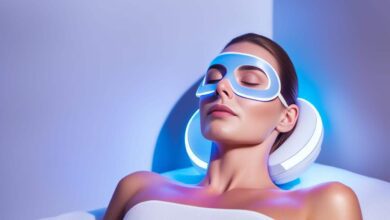The 20 Best Oils & Serums for face | Radiant Skin Guide
"Achieve a Glowing Complexion with These Top Picks"

Getting a glowing, young look is easy with many face oils and serums out there. This guide shows the top 20 that can make your skin look new. They help with dullness and fine lines12.
If you have oily skin, acne, or signs of aging, this guide is for you. It gives expert advice and tips to improve your skincare. Learn about ingredients like vitamin C, retinol, and hyaluronic acid. Find out how to mix serums for the best effects. Get ready for a glowing, young look with the best face oils and serums here.
Key Takeaways
- Discover the top 20 face oils and serums for radiant, youthful skin
- Learn how to address specific skin concerns with targeted formulas
- Understand the benefits of key ingredients like vitamin C, retinol, and hyaluronic acid
- Explore the art of layering multiple serums for maximum effectiveness
- Elevate your skincare routine with expert recommendations and tips
Why Use Face Serums?
Face serums are key for any skincare routine. They are light and packed with active ingredients. These ingredients go deep into the skin to fix specific problems3. Unlike thick moisturizers, serums don’t block pores. This lets the ingredients work better.
Deeper Penetration for Effective Results
Serums go deep into the skin. They help with things like dark spots, fine lines, and acne3. Because they are small, they can get to deep skin layers. This helps fix problems at their source better than other products.
Lightweight, Non-Occlusive Formulas
Serums are light and won’t clog pores or feel greasy4. They let the skin breathe and absorb fast. This means the ingredients can work well without upsetting the skin’s balance.
Adding face serums to your skincare can really change things for the better345.
“Serums hydrate the skin with humectants like glycerin and hyaluronic acid, deliver antioxidants, such as niacinamide and vitamin C, and regulate skin tone with ingredients like tranexamic acid and glycolic acid.”3
When and How to Apply Serums
To get the most out of your face serums, apply them right. Serums should be applied to clean skin, before your moisturizer.6 This lets the active ingredients soak deep into your skin. Then, put a moisturizer on to keep the benefits in and keep your skin hydrated.
Timing is Key: Serums First, Then Moisturizer
Always put serums on before moisturizers7. This way, the active stuff in the serum gets into your skin well. Putting serum first also makes your moisturizer go on smoothly and lock in the good stuff.
- Apply serum to clean, dry skin6.
- Gently press the serum into your skin using your fingertips, focusing on areas of concern7.
- Wait about a minute before putting on your moisturizer7.
- Finish with your moisturizer to keep the serum’s benefits in6.
By doing this, your serums will work best to make your skin look better. Remember, a little serum is enough, so start with a pea-sized amount and add more if needed.7
“Applying serums before moisturizers allows the key ingredients to fully penetrate and work their magic on the skin.”
Layering Multiple Serums
You can use more than one face serum to tackle different skin issues8. But, don’t put too many active things on your skin at once. This can make your skin get red and irritated9. Instead, mix serums that work well together, like an antioxidant one in the morning and a retinol one at night. This way, you make a plan that fits your skin’s needs9.
Tailoring Your Routine for Specific Concerns
Think about your skin type and what it needs when using serums9. In Japan, people have used serums for a long time in their skincare. Experts say to use up to three serums at a time8. This way, you can treat your skin well without making it too stressed.
- For dry skin, put a hydrating serum on first, then a serum with oils to keep moisture in9.
- For aging skin, mix a vitamin C serum for brightening with a retinol serum for anti-aging9.
- If you have acne, use a salicylic acid serum, then a calming one to soothe your skin9.
Start with the lightest serums and move to the thicker ones10. Let each serum soak in before adding the next to avoid clumping and get the best results9.
“Cocktailing” different serums can be a time-saving method to address multiple skin concerns at once, according to beauty chemist David Pollock8.
Massage your serums in to get oxygen to your skin and make them work better8. But, be careful mixing strong products like peels or retinol. They can irritate your skin9.
By carefully choosing and layering serums, you can get a glowing and healthy face9.
Best Serum for Oily Skin
The Shani Darden Lactic Acid Exfoliating Serum is great for oily skin11. It has lactic acid and polyhydroxy acids to gently clean pores. Hyaluronic acid, aloe, and green tea balance and calm the skin11. It’s light and won’t clog pores, perfect for those with breakouts11.
Look for salicylic acid, niacinamide, and hyaluronic acid in oily skin serums11. Salicylic acid fights acne and clears pores11. Niacinamide controls oil, lowers inflammation, and makes pores look smaller11. Hyaluronic acid keeps skin moist without oiliness11. Retinol, tea tree oil, and peptides also help with oily skin11.
The Shani Darden Lactic Acid Exfoliating Serum costs $88 at Sephora12. Other good choices are the INKEY List SuperSolutions 20% Niacinamide Serum ($18 at Sephora)12 and the CeraVe Resurfacing Retinol Serum ($17 at Amazon)12.
Oily skin can last beyond being a teenager, especially for men and women during ovulation13. Things like genes, hormones, and diet can make skin produce more oil13. The right serum can help balance oily skin for a glowing look13.
“The Shani Darden Lactic Acid Exfoliating Serum is a game-changer for my oily, acne-prone skin. It leaves my complexion looking clearer and more refined without over-drying.”
Oils & Serums: Dispelling the Myths
Many people avoid face oils and serums because of myths. But, not all oils are the same. Many can really help your skin, no matter what type you have14.
Some think oils make pores clog and cause breakouts. But, oils like grape seed, coconut, and jojoba don’t usually do that14. These oils can make your skin stay moist and even help stop it from losing moisture. They can also make fine lines and wrinkles less noticeable14.
Serum oils are special. They are light and go deep into your skin for better results15. They have lots of antioxidants, vitamins, and fatty acids. These help your skin stay healthy and full of life15.
| Oil-Based Serum Myth | Fact |
|---|---|
| Oils will clog pores and cause breakouts | Non-comedogenic oils like grape seed, coconut, and jojoba are less likely to congest the skin14 |
| Oils are too heavy and greasy | Serum oils offer deep hydration without a heavy, greasy feel, thanks to their lightweight formulas15 |
| Oils don’t absorb well into the skin | Serum oils, like the Pear Serum Oil, have unique formulations that allow for instant absorption and nourishment16 |
Choosing the right face oils and serums is key. Look for ones that fit your skin type and problems16. Serums with oils and other ingredients can help with many skin issues, like acne or aging16.
Don’t let myths stop you from trying face oils and serums. Learn about their benefits to get glowing, healthy skin16.
Choosing the Right Oil-Based Serum
When picking an oil-based serum, choose non-comedogenic oils that won’t block your pores17. For skin that’s oily or prone to acne, great picks are jojoba oil, rosehip oil, and argan oil. These oils are from plants and won’t clog your pores17. They also give deep hydration without causing breakouts.
Non-Comedogenic Oils for Acne-Prone Skin
Facial oils come from fruits, nuts, and seeds. They can fight inflammation or act as antioxidants17. But, if you have acne-prone skin, pick oils that won’t clog your pores17.
- Jojoba oil – This oil is like your skin’s natural sebum. It’s perfect for oily or acne-prone skin.
- Rosehip oil – It’s full of vitamin C and essential fatty acids. Rosehip oil helps reduce inflammation and heal skin, great for acne-prone skin.
- Argan oil – This oil is light and won’t feel greasy. It’s full of antioxidants and won’t clog pores, good for acne-prone skin.
When making your skincare routine, use these non-comedogenic oils to feed and hydrate your skin without clogging pores17. The right oil-based serum can give you clear, glowing skin17.
“Personalized selection of serums and oils should be based on skin concerns and preferences.”
| Skin Concern | Beneficial Ingredients |
|---|---|
| Acne-Prone Skin | Vitamin C, Retinol, Zinc, Salicylic Acid |
| Dry Skin | Vitamin E, Niacinamide, Glycolic Acid, Hyaluronic Acid |
| Dull Skin | Green Tea Extract, Resveratrol, Ferulic Acid |
Remember, choosing serums and oils should be personal17. Think about your skin type and what it needs to pick the best oil-based serum for you17.
Benefits of Oil-Based Serums
Oil-based serums make your skin glow and look great. They go deeper into your skin than water-based ones, giving you lasting moisture18. These serums also help your skin absorb active ingredients better, making them work better18.
These serums do more than just hydrate. They help make your skin’s barrier stronger. This means they give your skin important nutrients for better health and look18. They’re great for people with sun damage, sun spots, or fine lines18.
Deeper Hydration and Moisture Retention
Oil-based serums give your skin deep, lasting hydration18. The oils in them go deep into your skin, giving it the moisture and nutrients it needs19. This is great for dry or dehydrated skin, making it feel soft and nourished for a long time.
Enhanced Absorption of Active Ingredients
Oil-based serums also make active ingredients work better in your skin18. The oils in them help these ingredients go deeper into your skin20. This means better results for things like acne, aging, or dull skin.
Choosing between oil-based and water-based serums depends on your skin type and what you need20. If you have oily or acne-prone skin, use oil-based serums at night to avoid shine during the day18. But if you have dry skin, oil-based serums can be a big help, giving you the moisture and nutrients you need.
Choosing between oil-based and water-based serums is up to you and what your skin needs20. Knowing the benefits of each type lets you pick the right one for your skin. This way, you can get the glowing, healthy skin you want.
Key Ingredients to Look For
When picking a face serum, look for certain key ingredients. Niacinamide is a top choice that fights redness and dark spots21. Azelaic acid and bakuchiol offer gentle retinol-like effects.
For brightening and exfoliating, try serums with alpha-hydroxy acids (AHAs) or beta-hydroxy acids (BHAs). These help clear pores and make skin glow.
Niacinamide, Azelaic Acid, and Bakuchiol
Niacinamide is great for many skin types. It balances oil, shrinks pores, and evens skin tone21. Azelaic acid and bakuchiol are gentler than retinol but still offer great benefits.
Exfoliating AHAs and BHAs
Alpha-hydroxy acids (AHAs) like glycolic acid and lactic acid smooth skin and lessen fine lines21. Beta-hydroxy acids (BHAs) like salicylic acid are perfect for acne, unclogging pores and reducing swelling21.
“Incorporating a targeted serum with key ingredients can truly transform the health and appearance of your skin.”
Knowing the benefits of these ingredients helps you pick the right serum. This way, you can tackle your skin issues and get a glowing, young look2122.
Antioxidant Serums for Daytime
A strong antioxidant serum, like one with vitamin C, is key for your skin during the day. It shields your skin from harm and makes it glow23. Vitamin C brightens your skin, evens out its color, and protects against harmful free radicals23. Using a vitamin C serum in the morning makes your skin look young and bright.
Vitamin C for Brightening and Protection
Choose a vitamin C serum that goes deep into your skin for the best effects23. The Protect Antioxidant Day Serum costs $62.00 and comes in Full-Size (30mL) and Travel-Size (10mL)23. It has antioxidants like pea peptides, green tea, and shiitake mushroom, plus hyaluronic acid that holds a lot of water23. This serum fights off environmental damage and aging signs, now on sale for $5023.
Antioxidant serums are different from oils because they are water-based and work deep in your skin23. This vitamin C serum is for all skin types and comes in eco-friendly glass23. Even though reviews might be in another language, it’s smart to check them yourself to see if it’s right for you23.
Antioxidant serums can cost from $69.00 to $325.0024. They help with many skin issues like dullness and dark spots24. You can find them in different forms, like lightweight liquids and serums, with ingredients like green tea and vitamin C24.
Think about your skin type and what you want to fix when picking an antioxidant serum24. Many are good for all skin types and are vegan and cruelty-free24. People love these serums for making their skin look better and feel smoother24.
Antioxidant serums protect your skin from harm, brighten it, and help make more collagen24. Some are made for darker skin tones and tackle issues like dryness and fine lines24.
Looking for a vitamin C serum? There are many great ones out there25. La Roche-Posay Anthelios AOX Daily Antioxidant Face Serum SPF 50 is a top pick, priced at $4525. Alastin Skincare A-Luminate Brightening Serum is great for reducing redness, at $16825. For older skin, Isdin Isdinceutics Flavo-C Ultraglican Daily Antioxidant Serum is a favorite, costing $11225.
Whether you want to brighten your skin, protect it, or fix specific issues, a good antioxidant serum can help24. Adding a vitamin C serum to your morning routine can give you a glowing, healthy look23.
Reparative Serums for Nighttime
As the sun sets, it’s time to focus on serums that help with aging and acne at night. Look for retinol in your serums. It helps make more collagen, lessens fine lines and wrinkles, and clears pores26.
Using a retinol serum at night can change your skin for the better. Studies show that Renew Resurfacing Night Serum makes fine lines and wrinkles less visible and keeps skin hydrated in 4 weeks26. It has ingredients like Hyaluronic Acid, Glycolic Acids, Alpha Hydroxy Acids, and Ferulic Acid. These work together to fight aging and sun damage26.
If you’re on a budget, try the Lactic Acid 10% + HA 2% Exfoliating Serum from The Ordinary for $9.2027. For a splurge, the Wrinkle Correction Serum at $29.99 is highly rated for wrinkles27.
No matter your budget or skin issues, there’s a retinol serum for you. Retinol is key for anti-aging and acne control. It’s a must-have in your nighttime serum routine2627.
Retinol for Anti-Aging and Acne Control
Retinol comes from vitamin A and is great for fighting fine lines, wrinkles, and acne2627. It helps by making cells turn over faster, clearing pores, and making more collagen. This means your skin looks younger and brighter26.
Adding retinol serums to your night routine can really change your skin. Neutrogena Rapid Wrinkle Repair Retinol Anti-Wrinkle Face Serum has over 3,800 five-star reviews on Amazon. It’s proven to reduce aging signs27.
Whether you’re fighting retinol for acne or want to look younger, there are many great serums out there. By using retinol in your nighttime serum, you can get smoother, younger-looking skin every day2627.
“Retinol is a true powerhouse ingredient for anti-aging and acne control, making it an essential addition to any nighttime serum routine.”
Conclusion
Face oils and serums are key for a good skincare routine. They make your skin look better in many ways. By picking the right ones, you can make your skin look young and bright28.
Do you have acne, dull skin, or signs of aging? The right face oil or serum can help. They come in light formulas that go deep into your skin and oils that keep moisture in. These can make your skin look just how you want29.
Learning how to use face oils and serums lets you make a skincare plan just for you. There are many options out there. With them, you can make your skin look its best. Try these powerful products and see your skin glow with youthfulness2829.
FAQ
What are the benefits of using face serums?
Face serums deeply penetrate the skin with active ingredients. They are light and don’t block pores. This lets them work better and target skin issues.
What are the key ingredients to look for in face masks for acne-prone skin?
Look for salicylic acid, benzoyl peroxide, sulfur, and clay in face masks for acne. These help clear pores, fight bacteria, and control oil.
When should I apply face serums in my skincare routine?
Put serums on clean skin before your moisturizer. This lets the ingredients soak in well. Then, put a moisturizer on to keep the good stuff in and keep skin hydrated.
Can I layer multiple face serums in my routine?
Yes, you can use several serums for different skin problems. But don’t use too many at once to avoid irritation. Use ones that work well together, like an antioxidant in the morning and retinol at night.
What are some of the best ingredients to look for in face serums?
Look for niacinamide, azelaic acid, bakuchiol, AHAs, and BHAs in serums. These help with things like dark spots, fine lines, and acne. Also, vitamin C serums are great for daytime protection.
Are oil-based serums suitable for oily or acne-prone skin?
Some think oil-based serums will clog pores, but that’s not always true. Non-comedogenic oils can deeply hydrate and nourish without clogging pores. Oils like jojoba, rosehip, or argan oil are good for oily or acne-prone skin.
Source Links
- 25 Face Serums That Deliver Smoother, Glowier Skin
- Use a Gua Sha? You Need a Great Face Oil—Here Are Our Favorites, Starting at Just $10
- Face Oils vs. Serums: When and How to Use Each
- Face Oil vs Serum: What’s the Difference?
- The Surprising Benefits of Oil-Based Face Serums
- How To Apply a Face Serum Correctly | No7 Beauty
- How To Apply Serums, Oils And Concentrates
- How to Layer Different Serums and Oils
- How Many Serums Can You Use at Once?
- How Do I Layer Multiple Serums?
- What Are The Best Skincare Serums For Oily Skin?
- Got Oily Skin? These Derm-Approved Serums Should Be On Your Radar
- How to choose the best face serum for oily skin | Curology
- Bust the Myths and Dispel the Doubts
- Serum Oils: Unveiling Benefits, Application Techniques, and Dispelling Common Myths – Dalia Botanique
- What Is A Serum Oil
- Facial Oils and Serums, how do I choose?
- Oil or Water Based: What’s the Right Product for You?
- Serums vs. Oils: What’s the Difference?
- Deep Dive Comparison of Serums vs Oils
- What Ingredients to Look for in a Facial Serum for Your Skin Type
- ProFractional Laser Treatment – Are you a Good Candidate?
- Protect Antioxidant Day Serum
- Antioxidant Serums | Sephora
- 17 Antioxidant-Infused Serums That Derms Love
- Renew Resurfacing Night Serum
- These expert-approved night serums work their magic while you’re sleeping
- THE MAGIC OF THE REGENERATING OIL SERUM – Witlof Skincare
- Decoding the Difference: Facial Oils vs. Face Serums




